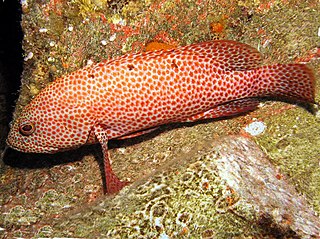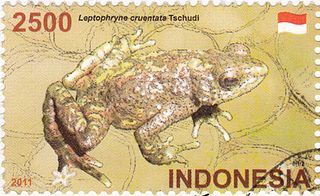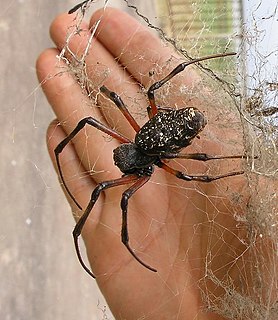Related Research Articles

Helicoverpa zea, commonly known as the corn earworm, is a species in the family Noctuidae. The larva of the moth Helicoverpa zea is a major agricultural pest. Since it is polyphagous during the larval stage, the species has been given many different common names, including the cotton bollworm and the tomato fruitworm. It also consumes a wide variety of other crops.

The graysby is a species of marine ray-finned fish, a grouper from the subfamily Epinephelinae which is in the family Serranidae which also includes the anthias and sea basses. It is found in the western Atlantic. It is associated with reefs and is a quarry species for commercial and recreational fisheries.

The bleeding toad, fire toad, or Indonesia tree toad is a species of "true toad", family Bufonidae, endemic to Java, Indonesia. Leptophryne javanica was included in this species prior its description as a distinct species in 2018, although the degree of differentiation between these species is low. Bleeding toad is listed as a critically endangered species due to a drastic population decline. The reasons of this decline are unclear, but the decline is consistent with chytridiomycosis, despite ambiguous identification.

Heliothis is a genus of moths in the family Noctuidae. It was first described by Ferdinand Ochsenheimer in 1816. Some of the species have larvae which are agricultural pests on crop species such as tobacco, cotton, soybean and pigeon pea. Some species originally in this genus have been moved to other genera, see Chloridea and Helicoverpa.

Nephilingis cruentata is an araneid spider with a strikingly red sternum.

The ochre-marked parakeet is a species of parrot native to Brazil. It is also known as blue-throated parakeet and red-eared conure in English and cotorra tiriba and perico grande in Spanish.

The red myzomela is a species of bird in the family Meliphagidae. It is found in New Guinea and New Britain. Its natural habitats are subtropical or tropical moist lowland forests and subtropical or tropical moist montane forests.

Methomyl is a carbamate insecticide introduced in 1966. It is highly toxic to humans, livestock, pets, and wildlife. The EU and UK imposed a pesticide residue limit of 20 µg/kg for apples and oranges.

Heliothis peltigera, the bordered straw, is a species of moth of the family Noctuidae.
Masalia was a genus of moths of the family Noctuidae. It is now considered to be a subgenus of Heliothis.

Demeton was a phosphorothioate insecticide with the chemical formula C8H19O3PS2. While it was previously used as an insecticide, it is now largely obsolete due to its relatively high toxicity to humans. The chemical structure of demeton is closely related to military nerve agents such as VX, and a derivative with one of the ethoxy groups replaced by methyl was investigated by both the US and Soviet chemical weapons programs under the names "V.sub.X" and "GD-7".

Heliothis ononis, the flax bollworm, is a moth of the family Noctuidae. The species was first described by Michael Denis and Ignaz Schiffermüller in 1775. It is found in China, Kazakhstan, central Asia, northern Mongolia (Khangai), the Russian Far East, the Korean Peninsula, southern European part of Russia, southern and central Europe, southern and eastern Siberia and Turkey. In North America it is found from south-central Manitoba west to British Columbia, north to the Northwest Territories and Yukon and Alaska and south to Colorado.
Heliothis perstriata is a species of moth of the family Noctuidae. It has been recorded from Iran and Punjab in India.

Chloridea subflexa is a moth of the family Noctuidae first described by Achille Guenée in 1852. It is found from most of the United States, throughout the Antilles, and south to Argentina.

Heliothinae is a small subfamily of moths in the family Noctuidae. There are about 400 species described worldwide. They are found predominantly in semiarid subtropical habitats.

Arene cruentata is a species of small sea snail, a marine gastropod mollusk in the family Areneidae.

Bursa cruentata is a species of sea snail, a marine gastropod mollusk in the family Bursidae, the frog shells.
V-sub x, also known as GD-7, is an organophosphate nerve agent of the V-series, the phosphonate analog of the organophosphate insecticide demeton.

Rhodopsalta cruentata, also known as the blood redtail cicada, is a species of insect that is endemic to New Zealand. This species was first described in 1775 by Johann Christian Fabricius and named Tettigonia cruentata.
Cytochrome P450, family 9, also known as CYP9, is a cytochrome P450 family found in Insect genome, CYP9 and insect CYP6 family belong to the same clan as mammalian CYP3 and CYP5 families. The first gene identified in this family is the CYP9A1 from the Heliothis virescens, which is involved in thiodicarb insecticide resistance.